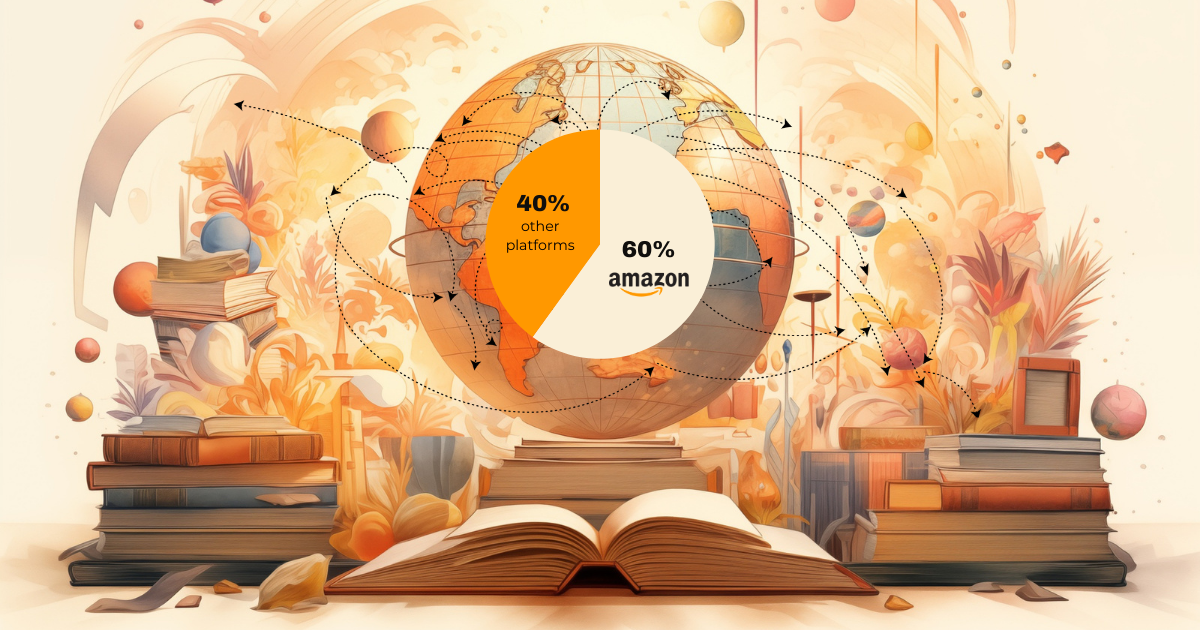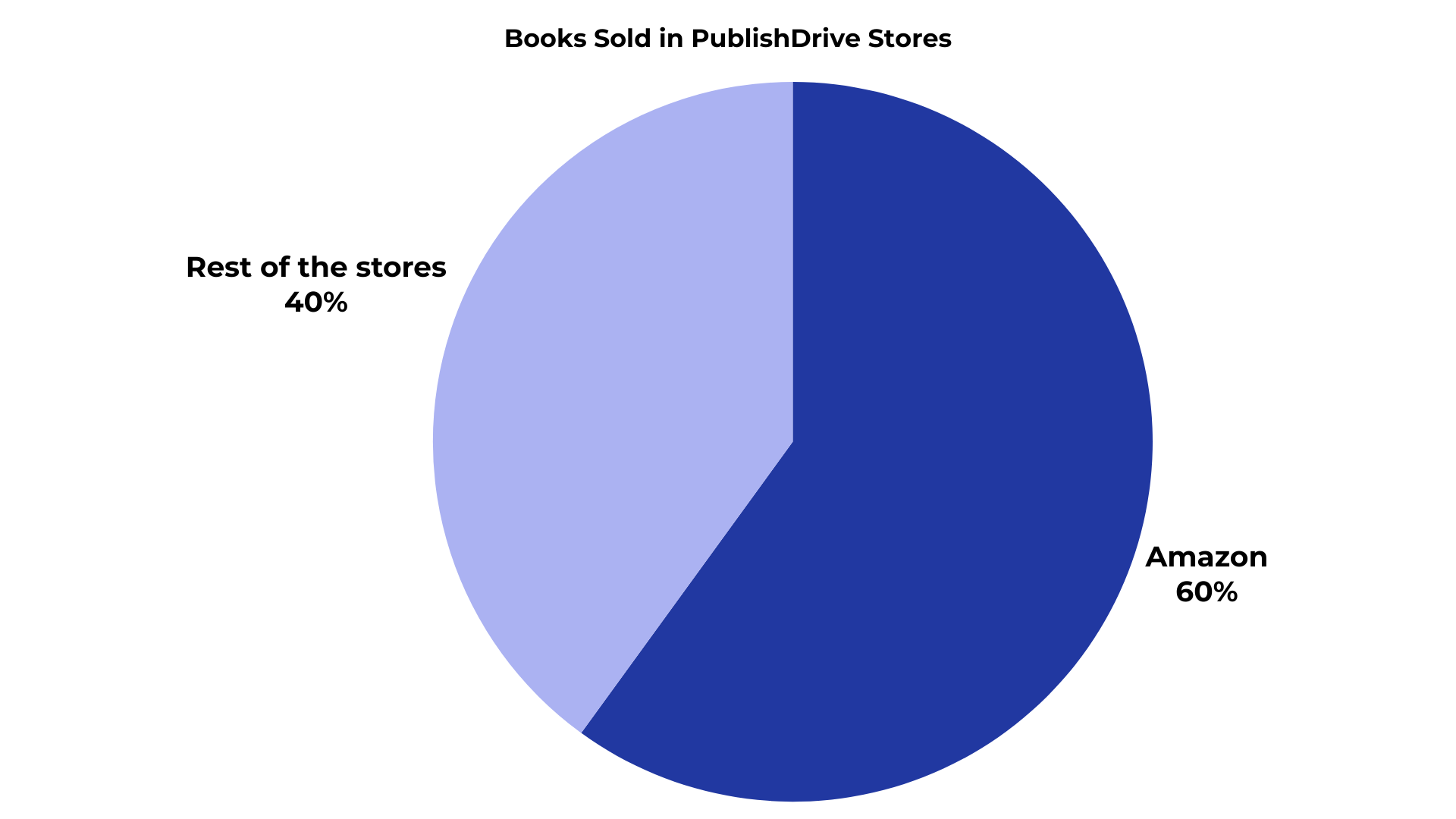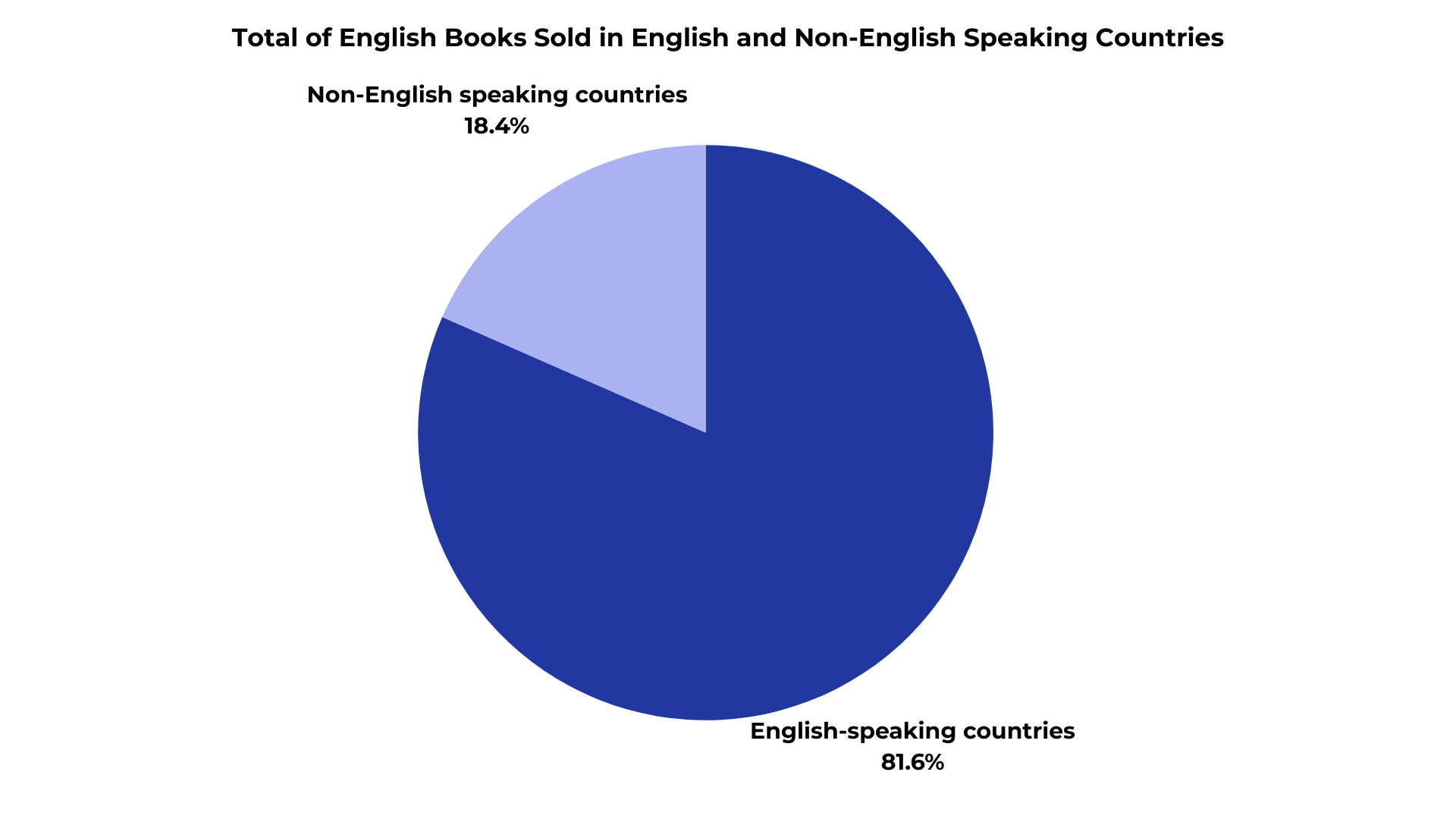Maximizing Reach: Tapping into the 40% Outside Amazon in Publishing

In the ever-evolving world of book publishing, authors and publishers constantly seek ways to maximize their reach and revenue.
Amazon looms large in the publishing landscape, offering authors an undeniable reach. But with great power comes great dependence.
While it dominates book sales, a surprising 40% of potential readers remain outside its grasp. Authors who publish solely on Amazon risk exposure to algorithm shifts, censorship, and stiff competition, leaving a vast audience undiscovered.
Key takeaways
- Authors and publishers can earn up to 40% more royalties by expanding distribution beyond Amazon. Sole reliance on Amazon can lead to missed opportunities due to algorithm shifts, policy changes, and tough competition within the platform.
- Going beyond Amazon offers access to diverse audiences, international markets, and flexible promotional strategies. Platforms like Apple Books, Barnes & Noble, Kobo, and independent bookstores provide unique opportunities for visibility and revenue generation.
- Contrary to common beliefs, wide publishing is not overly complicated or detrimental to sales on Amazon. It offers benefits such as reduced dependence on a single retailer, broader reach, and control over pricing and promotions.
There’s Huge Potential outside the E-commerce Giant
According to our 2023 book market report, authors and publishers stand to make a staggering 40% more royalties by expanding their distribution beyond Amazon.

Solely relying on Amazon can be a gamble. Algorithm changes can bury your book, policies can shift unexpectedly, and fierce competition within the platform makes visibility tough. But the true limitation lies in reach: 40% of readers use other platforms like Apple Books, Barnes & Noble, Kobo, and independent bookstores.
Each platform has something specific – the reach, the way it operates, or the many promotional opportunities – that authors and publishers can use to their advantage. Apple Books boasts a loyal Apple device user base, Barnes & Noble offers physical and digital options, Kobo caters to international readers, and independent bookstores champion author discovery.
Through publishing wide, you can step outside the walled garden and enter a diverse ecosystem.
Why Go Wide? The Power of Diversification
Publishing wide opens doors to new audiences, boosting sales potential. Discoverability increases as your book appears on multiple platforms, improving its chances of getting picked up by readers actively searching there. Beyond finance, going wide grants you control over pricing and promotions and strengthens your author brand by solidifying your presence across the reading landscape.
Other things that make publishing wide a better option:
1. Distribution to English and non-English audiences
One of the key reasons behind this surge in royalties is the growing popularity of alternative platforms that cater to international audiences. Unlike Amazon, which primarily focuses on English-speaking markets, these platforms offer access to a diverse range of readers spanning various languages and regions.

2. Access to international stores
Publishing wide means not only distributing through more than one platform but making your book available in as many countries as possible.
PublishDrive boasts a global distribution network comprising over 400 stores and 240,000 digital libraries worldwide. By leveraging such platforms, authors and publishers can tap into previously inaccessible markets and connect with readers on a global scale.
3. Eliminated risks
Publishing on multiple platforms reduces dependence on a single retailer, mitigating the risk of sudden policy changes or algorithm updates that could impact sales. Diversifying distribution channels not only safeguards against unforeseen disruptions but also fosters resilience in the face of industry fluctuations.
4. Flexibility in terms of promotional strategies
Another compelling reason to explore alternative platforms is the flexibility they offer in terms of pricing and promotional strategies. Unlike Amazon, which imposes strict pricing policies and promotional constraints, other platforms empower creators to experiment with different pricing models and marketing tactics tailored to their target audience.
Apple Books, for example, favors book promotions, has affiliate programs and stands out as one of the few ebook retailers (alongside Google Play Books) that indexes book descriptions in its search, offering authors significant control over their book's search visibility.
💡Whether you publish with one platform or with an aggregator, promotional tactics and a solid marketing strategy are a must.
- You have to start promoting your book so others will notice it, buy it, and write reviews, which is the best kind of promotion.
Indie authors who don't know where and how to promote their books end up signing an exclusivity contract with Amazon KU. - Being an industry giant, this makes sense. However, authors potentially lose a big chunk of royalties they could make by publishing and promoting their books on other platforms.
- Authors and publishers need to know there are platforms that, besides offering wide distribution, also integrate marketing tools to make their work much easier.
Common Misconceptions about Going Wide
1. Wide publishing requires more work
It can be more work if you publish to each platform individually. But it requires much less work if you publish with an aggregator that sends your book to all retailers at the same time. Moreover, an aggregator such as PublishDrive has built-in book promotion tools, so you can manage everything from one platform, from publishing to distribution and marketing.
2. Wide publishing is too complicated for beginners
With aggregators and helpful resources available, going wide is more accessible than ever.
Publishing on multiple platforms with an aggregator doesn't require any kind of previous experience in self-publishing. The process is straightforward and accessible to anyone.
3. Wide publishing hurts sales on Amazon
If people want to buy your book from Amazon, they can simply buy it. If other readers have other preferences and go to Kobo, for example, they'll buy your book from there. It's still a sale you made, and it's all about the reader's preferences when it comes to these platforms.
While there might be some initial adjustments in sales patterns across platforms, the overall impact is often positive for authors. Every sale, regardless of the platform, brings royalties and expands your reader base.
Authors & Publishers Who Publish Wide
Marc Reklau
Marc Reklau, the author behind the widely acclaimed book 30 Days – Change Your Habits, Change Your Life, has been making waves in the literary world.
Initially, Marc's books were exclusively available on Amazon until an unexpected hiccup led to the closure of his account. However, he saw this setback as an opportunity to diversify his distribution strategy. Embracing platforms like PublishDrive, he expanded his reach to a wider audience, tapping into more stores than ever before.
For Marc, PublishDrive has been a game-changer in his publishing journey. In just over five months of using the platform, he's found it incredibly user-friendly and efficient, saving him valuable time. Plus, the wide distribution network has allowed his books to gain traction, particularly on platforms like Apple and Google.
Thanks to PublishDrive, Marc has seen an uptick in sales.
Read the full case study here.
Quinn Loftis
Quinn is a multi-award-winning author who primarily writes paranormal romance for her dedicated readers, ranging from young adults to mothers and beyond.
She runs a self-publishing business with her husband, Bo Loftis. While Quinn does all the world-building for her expansive fanbase, Bo takes care of everything else.
"When you're selling 5,000 books a month at 10% versus a flat fee of 100 bucks, that's sort of a no-brainer...We can use PublishDrive, save a ton of money, and still reach the same audience and actually a bigger audience, which is awesome, too. When I first heard about that, I almost thought it was too good to be true." — Bo Loftis
Read the full case study here.
J-Novel Club
J-Novel Club is a digital publishing company specializing in licensing, translating, and releasing Japanese manga and light novels in English. They roll out approximately 20 volumes monthly in both digital and print formats. Through membership access, readers worldwide can enjoy the latest digital releases.
The company's growth has been remarkable, jumping from publishing four books in 2016 to a staggering 220 new releases in 2021. With such rapid expansion, a pressing need arose for more staff, optimization, and support.
Initially, J-Novel Club engaged directly with major stores like Amazon, Apple, and Google while also branching out to platforms like Kobo and OverDrive. However, managing their extensive catalog and ensuring consistent metadata across all platforms proved to be a labor-intensive task.
To streamline their operations and maximize revenue, J-Novel Club made the switch to PublishDrive. This transition resulted in a significant increase in revenue, amounting to tens of thousands of additional dollars. The flexibility provided by PublishDrive allowed them to publish books on Amazon that wouldn't have met KDP's criteria, further enhancing their revenue stream.
Read the full case study here.
Bethany Atazadeh
Bethany is not a PublishDrive author, but she also chose to publish her book on multiple platforms. If you watch the video, you’ll see that 37,5% of her royalties come from platforms other than Amazon.
Conclusion
While Amazon undoubtedly remains a crucial player in the publishing ecosystem, there's potential for growth and profitability beyond its borders.
By embracing alternative platforms and expanding their distribution reach, authors and publishers can unlock new opportunities, reach diverse audiences, and maximize their earnings.
As our report suggests, the 40% increase in royalties speaks volumes about the untapped potential awaiting those willing to venture beyond Amazon while still distributing to this industry giant.